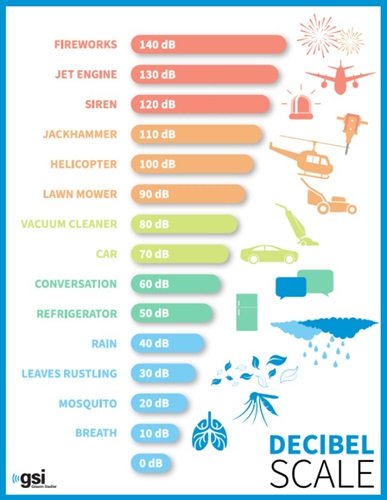As we celebrate Better Hearing Month, we wanted to take the time to talk about protecting your hearing. This blog entry has been written as a patient-focused overview on protecting yourself from Noise-Induced Hearing Loss. In this blog we cover dangerous vs. safe decibel levels, and when it’s necessary to wear hearing protection. We encourage you to share this with your patients as a resource on hearing health, what the different decibel levels mean, and what steps can be implemented to protect hearing.
Noise-Induced Hearing Loss
There are a few types of hearing loss, but Noise-Induced Hearing Loss (NIHL) is the only kind of hearing loss that is completely preventable. From lengthy concerts to a quick gunshot sound, any length of noise at a high decibel can put you at risk for NIHL.
Dangerous vs. Safe Decibel Levels
Take a look at the chart below to see which everyday sounds are in a safe decibel range and which sounds are in a dangerous decibel range.

Signs That Noise is Too Loud
If someone is in an environment that is too loud, there will be signs. It’s important to know what signs to look out for when you feel that you’re in a loud environment:
- Raising your voice to be heard
- Unable to hear or understand someone 3 feet or less away from you
- Speech around you sounds muffled or dull after you leave the noisy area
- Experiencing decreased hearing or ringing in your ears for a few minutes or a few days after you hear the noise
If any of these signs are displayed, it’s best to avoid those situations or activities unless proper hearing protection is worn.
Protecting Your Hearing
- Wear Hearing Protection: Protect your hearing with earplugs, especially if you are an avid concert attendee, motorcycle rider, or work in construction. Earplugs completely block the ear canal, ensuring the sound is cut down by 15 to 30 decibels by the time it reaches your middle ear. Earmuffs are another option for protecting your hearing. By completely covering the outer ear, earmuffs are an option that fits most people.
- Turn Down the Volume: When listening to music or podcasts, it’s recommended to not set the volume higher than half of the highest volume. The World Health Organization recommends volume levels no higher than 80 dB for adults and 75 dB for children on personal listening devices.
- Move Away from The Source: If you’re attending a loud event, choose to stand or sit away from the source of the sound. You’d be surprised what a few yards of distance can do when it comes to hearing protection! Whether the event you’re attending has large speakers or a firework show, it’s best to be aware of the source of sound and pick a location away from it.
Unfortunately, NIHL is usually slow, painless, and permanent. This means you won’t know damage is being caused until it is already too late. Be proactive and protect your hearing by following our tips. Now is the time to take care of your hearing to ensure healthy hearing for years to come.
Sources:
https://www.asha.org/public/hearing/loud-noise-dangers/#:~:text=You%20can%20listen%20to%20sounds,noise%20levels%20over%2085%20dBA.
https://hearinghealthfoundation.org/keeplistening/decibels
https://www.nidcd.nih.gov/health/noise-induced-hearing-loss
https://www.who.int/publications/i/item/9789241515276
Tony received his master's from the University of Wisconsin-Oshkosh with an emphasis on pediatric audiology. He has over 20 years of experience in the hearing industry and has worked in a variety of settings. He has experience performing diagnostic testing with all age ranges, industrial audiology, retail, hearing aid financing and insurance, practice development programs and industry trade shows. At GSI, Tony is focused on training, support and education.